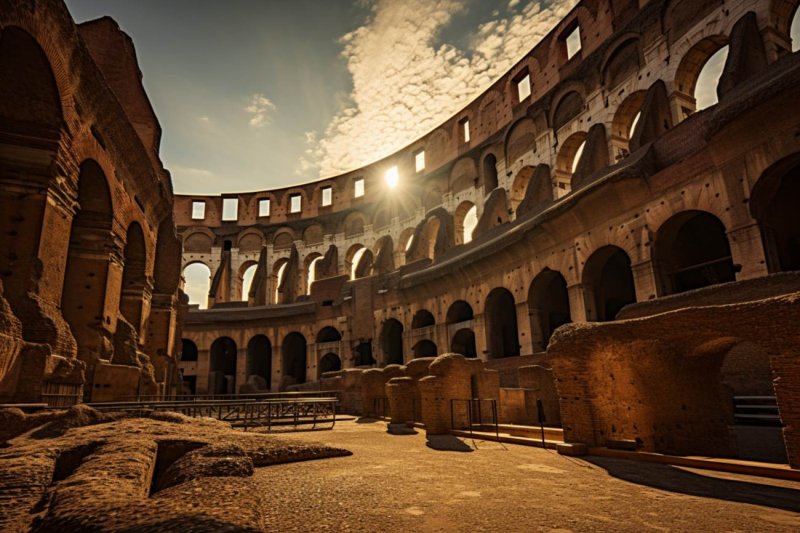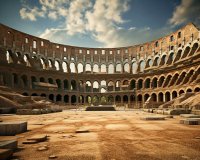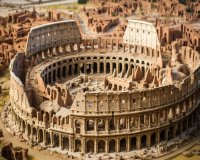Arena Spectacle: The Colosseum Floor and its Tales

Arena Spectacle: The Colosseum Floor and its Tales in Rome
The Colosseum, also known as the Flavian Amphitheatre, stands as one of Rome's most iconic and enduring symbols. This monumental structure, located in the heart of Rome, has been a witness to countless tales of valor, bloodshed, and entertainment. The Colosseum's arena floor, in particular, played a pivotal role in shaping the history and culture of ancient Rome.
The Colosseum's construction began in AD 70-72 under the emperor Vespasian and was completed in AD 80 by his son, Titus. This elliptical amphitheater could hold an estimated 50,000 to 80,000 spectators, making it a grand venue for various events, especially the gladiatorial contests that Rome is so famous for.
Gladiatorial Contests:
The Colosseum's arena was the central stage for the gladiatorial contests, which were a form of entertainment and a display of martial prowess. These battles pitted trained warriors against each other or wild animals. It was a brutal but captivating spectacle that enthralled the Roman populace. These gladiatorial fights showcased not only the physical strength and combat skills of the participants but also the political power and wealth of the emperors who sponsored them.
Gladiators, often slaves or prisoners, had to fight for their lives, and their fate was decided by the whims of the audience. The arena's floor was stained with the blood and sweat of these gladiators, and the sand covering the surface soaked up their stories of triumph and tragedy.
Naval Battles (Naumachiae):
One of the most astonishing feats that the Colosseum's floor could accommodate was the recreation of naval battles. To stage these spectacular shows, the arena was temporarily flooded, and full-scale ship replicas were brought in for battle. This dramatic display of naval warfare was a testament to the engineering marvel of the time, as well as a testament to the extravagance of the Roman emperors who spared no expense to entertain their citizens.
Animal Hunts:
In addition to human combat, the Colosseum floor was the setting for elaborate animal hunts. Exotic animals, such as lions, tigers, and elephants, were brought into the arena to fight against each other or against the gladiators. The sight of these fierce creatures in battle was awe-inspiring, and it demonstrated the vast reach of the Roman Empire in terms of animal acquisition and transport.
The Colosseum itself has a subterranean network of tunnels and chambers beneath the arena floor, which were used to house animals, gladiators, and equipment. Trapdoors and elevators allowed for dramatic entrances, adding an element of surprise to the events.
Christian Martyrdom:
The Colosseum also witnessed a darker side of history, as it became the site of Christian martyrdom during the Roman persecutions. Many early Christians were thrown into the arena to face death at the hands of wild beasts or gladiators, as a form of entertainment for the Roman crowds.
Today, the Colosseum stands as a UNESCO World Heritage Site and a symbol of both Rome's architectural prowess and its complex history. It serves as a testament to the past and a reminder of the grandeur, cruelty, and extravagance of ancient Rome. The tales of the Colosseum floor continue to captivate the imagination, showcasing a remarkable chapter in the history of one of the world's most iconic landmarks.
In conclusion, the Colosseum's arena floor in Rome has played a central role in shaping the city's history and cultural identity. From gladiatorial contests and naval battles to animal hunts and Christian martyrdom, the stories etched into its sand-covered surface reveal the fascinating and often brutal history of ancient Rome.
Rome: Unveiling Ancient Marvels with Multimedia Insight
Embark on a historical journey through Rome's iconic landmarks with the Colosseum and Roman Forum Ticket, enhanced by a captivating multimedia video. This immersive experience allows you to delve into the heart of ancient Rome, providing a glimpse into daily life and significant events.
Commence your adventure at the activity provider's office, where you'll not only collect your tickets but also enjoy a brief multimedia presentation offering insights into the city's rich history. The multimedia video sets the stage for your exploration of the Archaeological Park, starting with the Roman Forum, Palatine Hill, and concluding with the awe-inspiring Colosseum.
Explore the Roman Forum, once bustling with everyday life, and marvel at the tomb of Emperor Julius Caesar. Wander through the ancient ruins at your own pace, soaking in the historical significance of each site. Continue your journey to Palatine Hill, the birthplace of Rome, and discover the residences of emperors and kings.
Cap off your experience with a visit to the colossal Colosseum, the grand amphitheater that witnessed gladiator fights, executions, and animal hunts. Immerse yourself in the grandeur of one of the Roman Empire's architectural marvels.
This ticket package includes entry to the Roman Forum, Palatine Hill, and the Colosseum. Additionally, you'll benefit from assistance at the meeting point, a 30-minute ancient Rome multimedia video, a paper city map, WiFi, and access to a convenient toilet lounge.
Important information:
- Meeting Point: Touristation office at Piazza Ara Coeli, 16
- Recommended to exchange your voucher facing Vittorio Emanuele II monument
- Duration: Approximately 3 hours
- Audio guide available in English, Italian, French, German, Portuguese, Japanese, Chinese, Russian, Spanish
Know before you go:
- Bring your passport or ID card
- Children will be escorted to the entrance of the Roman Forum
- Not suitable for school groups, group guided tours, and private guided tours
- Ticket price includes a supplement for the emergency situation caused by floods in Emilia Romagna
Don't miss this opportunity to witness the splendor of Rome's ancient wonders. Reserve your spot now and pay later for a seamless travel experience.
Tales of the Restored Arena in Rome
The Restored Arena in Rome stands as a testament to the grandeur of ancient Roman architecture and the enduring spirit of gladiatorial combat. This iconic structure, also known as the Colosseum, has a rich history that echoes through the ages.
Origins and Construction:
The Colosseum, commissioned by Emperor Vespasian in AD 72, was completed under the reign of his successor, Titus, in AD 80. This colossal amphitheater was built to host a variety of public spectacles, including gladiator contests, animal hunts, and mock sea battles.
Architectural Marvel:
Constructed with travertine limestone and volcanic rock, the Colosseum featured a complex system of tunnels and elevators to transport gladiators and animals to the arena floor. Its elliptical shape and tiered seating could accommodate up to 80,000 spectators, showcasing the engineering prowess of ancient Rome.
Gladiatorial Combat:
The Restored Arena was synonymous with gladiatorial combat, where skilled fighters engaged in mortal combat for the entertainment of the masses. These events were often elaborate, with fighters representing different classes and armed with various weapons.
Historical Significance:
The Colosseum became a symbol of Roman entertainment and imperial might. It witnessed the rise and fall of emperors, the glory of victorious gladiators, and the collective roars of the Roman populace. Over the centuries, the arena underwent various modifications and repairs, earning its moniker as the "Restored Arena."
Decline and Preservation:
With the decline of the Roman Empire, the Colosseum fell into disuse and neglect. However, its structural integrity and historical importance led to preservation efforts in the modern era. The Colosseum stands today as one of the most visited and recognizable landmarks in the world.
Modern Significance:
The Restored Arena continues to captivate visitors with its awe-inspiring architecture and the echoes of a bygone era. It serves as a cultural and historical hub, attracting tourists, scholars, and history enthusiasts from around the globe.
Conclusion:
The Tales of the Restored Arena in Rome are etched in the annals of history. From its grand construction to the epic gladiatorial battles, this iconic structure is a symbol of the glory and decadence of ancient Rome. The Colosseum stands as a timeless testament to the enduring legacy of a once-mighty empire.
The Mythology and History of the Colosseum in Rome
The Colosseum, also known as the Flavian Amphitheatre, is one of the most iconic and enduring symbols of ancient Rome. This magnificent structure has captured the imaginations of people for centuries, and its rich history is intertwined with both mythology and real events.
The construction of the Colosseum began in AD 70-72 under the emperor Vespasian, and it was completed in AD 80 by his son Titus. The amphitheater, located in the heart of Rome, could hold an estimated 50,000 to 80,000 spectators. Its grandeur and scale are a testament to the architectural and engineering prowess of the ancient Romans.
Mythological Connections
One of the most captivating aspects of the Colosseum's history is its connection to Roman mythology. The name "Colosseum" is believed to be derived from the colossal statue of Nero, known as the Colossus of Nero, that once stood nearby. According to legend, this statue was repurposed to represent the sun god, Sol. Thus, the Colosseum was associated with both the gods and the emperors, symbolizing their power and divine connection.
Another mythological link to the Colosseum lies in the games and events that took place within its walls. The gladiatorial contests and animal hunts were often framed as acts of valor and sacrifice to the gods. These spectacles, while brutal by modern standards, were considered a form of entertainment and a display of Roman strength and piety.
Historical Significance
Beyond its mythological connections, the Colosseum played a vital role in Roman history. It was the epicenter of public entertainment, hosting a wide range of events, from gladiatorial battles to mock sea battles. The amphitheater was also a powerful tool for emperors to gain favor with the Roman populace. Providing free admission to these events was a common practice, solidifying the support of the people.
One of the most infamous events in the Colosseum's history was the persecution of Christians. Many early Christians faced martyrdom within these walls, facing various forms of execution for their beliefs. This dark chapter in the Colosseum's history serves as a reminder of the complexities of ancient Rome's religious and political landscape.
Decline and Preservation
As the Roman Empire declined, so did the Colosseum. It fell into disuse and disrepair, and its stones were used to construct other buildings. However, efforts to preserve this ancient wonder began in the Middle Ages, as it became a symbol of Rome's enduring legacy.
Today, the Colosseum stands as a UNESCO World Heritage Site and a testament to both the grandeur and brutality of ancient Rome. It attracts millions of visitors each year who come to marvel at its architecture, learn about its history, and reflect on the enduring impact of Roman culture.
Conclusion
The Colosseum's intertwined mythology and history make it a unique and captivating landmark. It stands as a testament to the grandeur of ancient Rome, the power of its emperors, and the diverse events that unfolded within its walls. From mythological origins to its role in shaping the history of the Roman Empire, the Colosseum remains an iconic symbol of Rome's legacy.







